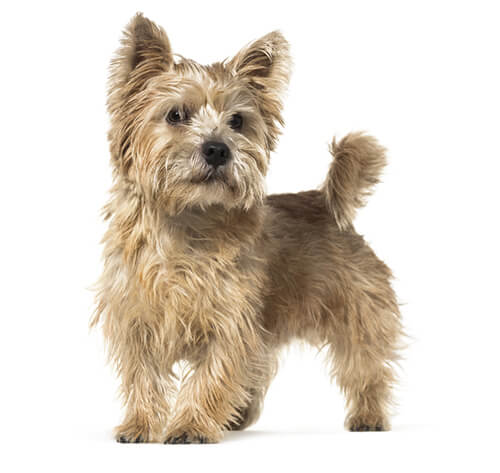
Norwich Terrier
A barnyard ratter from England, the Norwich Terrier is a spirited, stocky dog with prick ears and a slightly foxy expression. Despite his small size, the Norwich is an eager and fearless worker of substantial substance. Due to the breed’s hunting instincts and typical terrier curiosity, he should have regular exercise. A fun-loving companion, the Norwich is ideal for city or country homes. His wiry coat requires regular stripping and brushing.
DID YOU KNOW? The name Norwich Terrier covered the drop-eared and prick-eared varieties until 1964, when the drop-eared variety was recognised in England as a separate breed, the Norfolk Terrier.
The need-to-know
- Dog suitable for non-experienced owners
- Some training required
- Enjoys active walks
- Enjoys walking an hour a day
- Small dog
- Minimum drool
- Requires grooming once a week
- Non hypoallergenic breed
- Chatty and vocal dog
- Guard dog. Barks and alerts
- May require training to live with other pets
- May require training to live with kids
Personality

Lively, friendly, active, intelligent, tenacious… despite their small size, the Norwich Terrier is all terrier, and requires plenty of entertainment and activity. In common with other terriers, the Norwich is often thought of as wilful and stubborn, but this is due to their independent nature and quick mind. You have to work hard to get a terrier on-side and working with you, but when you do it is worth the effort.
Early socialisation and training is necessary with cats, small furry pets and livestock, as their original working instinct is a part of the Norwich’s terrier nature.
History and Origins

Country of Origin: England
The Norwich Terrier’s origins can be found closely linked to Cambridge University where, in the late 1800s, it became fashionable for some of the undergraduates to own a particular type of terrier that was being bred in a livery stable in Trumpington Street which ran along the back of several of the colleges. These small working terriers were put to work as college ratters, and as the students lived and socialised together, their dogs had to be equally social, and indeed they would often work in a pack. It was one of these dogs, a sandy coloured one called Rags, that is credited with being the founding father of both the Norwich and Norfolk Terriers that we know today.
Until 1964, the drop eared dogs were still classified as Norwich Terriers but after this date, the two were kept separate with the prick-eared dogs retaining the original name.
Nutrition and Feeding

Small dogs have a fast metabolism, meaning they burn energy at a high rate, although their small stomachs mean that they must eat little and often. Small-breed foods are specifically designed with appropriate levels of key nutrients and smaller kibble sizes to suit smaller mouths. This also encourages chewing and improves digestion.
Exercise

The Norwich Terrier requires an hour or more exercise each day, but will happily take more if you are offering it. Ensure a variety of activities, training, games, digging and chasing toys to keep your Norwich Terrier engaged and avoid boredom.
Other Information

Health and Common Issues
Like many small breeds, they can suffer from kneecaps that may temporarily slip out of place (luxating patellas) but generally the Norwich Terrier is generally a healthy, hardy dog with few health problems. The breed club monitor the health of the breed carefully and should be contacted for the most up-to-date information and details of any DNA or additional testing they recommend. Breed Clubs can be found on the Kennel Club website.
Space Requirements
Being small, the Norwich Terrier can live in any sized home, however a secure garden with solid fencing is important as they are agile and more than capable of digging under fencing or squeezing through the smallest of gaps. Alert and vocal, the Norwich Terrier may find city living overwhelming, but suburban, semi-rural and countryside living with access to plenty of walks and secure spaces to run and chase will be ideal.
Training Norwich Terrier
Early socialisation and habituation with children, cats, small furry pets and livestock is vital. The Norwich is a clever little dog and will learn quickly with positive reinforcement-based methods and a good understanding of what makes a terrier tick. Appropriate outlets for chasing, tugging, digging and chewing will meet your Norwich’s needs and keep them happy. Recall training is a must as the Norwich will be keen to chase anything they consider ‘prey’. This is a fun little dog who will enjoy trick training and is capable of mini agility, scent work and more.
Best Family Dog Breeds
Better suited to homes with older children, and quieter homes. The Norwich Terrier is sharp and alert, meaning that the busy home may be over-stimulating, resulting in a stressed and likely noisy dog who cannot settle. Older teenagers who can help with training will enjoy working with this fun little dog. While many dogs are traditionally thought of as being good with children, all dogs and children need to be taught to get on with and respect each other, and be safe together. Even so, dogs and young children should never be left alone together and adults should supervise all interactions between them.
Did You Know?
- People get confused which is the Norwich and which is the Norfolk. Just remember that there is an ‘f’ in Norfolk and they have the ‘folded’ ears whilst the Norwich has pointed ears like a ‘witch’s hat’.
- Because they’re short and stocky, they’ll usually sit with their feet straight out and when they lie down, their feet will either stick straight out to the side or behind them.
- Norwich Terriers are one of the smallest of the terrier types.
- They’re often referred to as a “big dog in a small package”.
- Norwich Terriers typically only have small litter sizes.